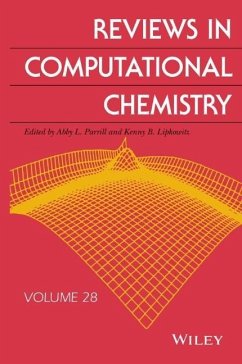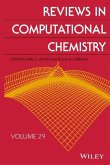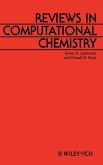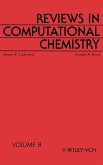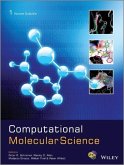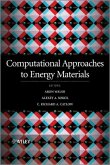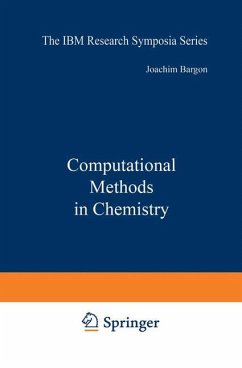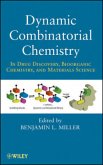Reviews in Computational Chemistry, Volume 28
Herausgegeben von Parrill, Abby L.; Lipkowitz, Kenny B.
Reviews in Computational Chemistry, Volume 28
Herausgegeben von Parrill, Abby L.; Lipkowitz, Kenny B.
- Gebundenes Buch
- Merkliste
- Auf die Merkliste
- Bewerten Bewerten
- Teilen
- Produkt teilen
- Produkterinnerung
- Produkterinnerung
The Reviews in Computational Chemistry series brings together leading authorities in the field to teach the newcomer and update the expert on topics centered around molecular modeling, such as computer-assisted molecular design (CAMD), quantum chemistry, molecular mechanics and dynamics, and quantitative structure-activity relationships (QSAR). This volume, like those prior to it, features chapters by experts in various fields of computational chemistry. Topics in Volume 28 include: * Free-energy Calculations with Metadynamics * Polarizable Force Fields for Biomolecular Modeling * Modeling…mehr
Andere Kunden interessierten sich auch für
![Reviews in Computational Chemistry, Volume 29 Reviews in Computational Chemistry, Volume 29]() Reviews in Computational Chemistry, Volume 29228,99 €
Reviews in Computational Chemistry, Volume 29228,99 €![Reviews in Computational Chemistry, Volume 1 Reviews in Computational Chemistry, Volume 1]() Kenny B. Lipkowitz / Donald B. Boyd (Hgg.)Reviews in Computational Chemistry, Volume 1380,99 €
Kenny B. Lipkowitz / Donald B. Boyd (Hgg.)Reviews in Computational Chemistry, Volume 1380,99 €![Reviews in Computational Chemistry, Volume 8 Reviews in Computational Chemistry, Volume 8]() Kenny B. Lipkowitz / Donald B. Boyd (Hgg.)Reviews in Computational Chemistry, Volume 8376,99 €
Kenny B. Lipkowitz / Donald B. Boyd (Hgg.)Reviews in Computational Chemistry, Volume 8376,99 €![Computational Molecular Science Computational Molecular Science]() Peter R. SchreinerComputational Molecular Science3.512,99 €
Peter R. SchreinerComputational Molecular Science3.512,99 €![Computational Approaches to Energy Materials Computational Approaches to Energy Materials]() Richard CatlowComputational Approaches to Energy Materials188,99 €
Richard CatlowComputational Approaches to Energy Materials188,99 €![Computational Methods in Chemistry Computational Methods in Chemistry]() Joachim BargonComputational Methods in Chemistry41,99 €
Joachim BargonComputational Methods in Chemistry41,99 €![Dynamic Combinatorial Chemistry Dynamic Combinatorial Chemistry]() Dynamic Combinatorial Chemistry122,99 €
Dynamic Combinatorial Chemistry122,99 €-
-
-
The Reviews in Computational Chemistry series brings together leading authorities in the field to teach the newcomer and update the expert on topics centered around molecular modeling, such as computer-assisted molecular design (CAMD), quantum chemistry, molecular mechanics and dynamics, and quantitative structure-activity relationships (QSAR). This volume, like those prior to it, features chapters by experts in various fields of computational chemistry. Topics in Volume 28 include:
* Free-energy Calculations with Metadynamics
* Polarizable Force Fields for Biomolecular Modeling
* Modeling Protein Folding Pathways
* Assessing Structural Predictions of Protein-Protein Recognition
* Kinetic Monte Carlo Simulation of Electrochemical Systems
* Reactivity and Dynamics at Liquid Interfaces
Hinweis: Dieser Artikel kann nur an eine deutsche Lieferadresse ausgeliefert werden.
* Free-energy Calculations with Metadynamics
* Polarizable Force Fields for Biomolecular Modeling
* Modeling Protein Folding Pathways
* Assessing Structural Predictions of Protein-Protein Recognition
* Kinetic Monte Carlo Simulation of Electrochemical Systems
* Reactivity and Dynamics at Liquid Interfaces
Hinweis: Dieser Artikel kann nur an eine deutsche Lieferadresse ausgeliefert werden.
Produktdetails
- Produktdetails
- Reviews in Computational Chemistry .28
- Verlag: Wiley & Sons
- 1. Auflage
- Seitenzahl: 560
- Erscheinungstermin: 4. Mai 2015
- Englisch
- Abmessung: 212mm x 212mm x 4mm
- Gewicht: 4011g
- ISBN-13: 9781118407776
- ISBN-10: 1118407776
- Artikelnr.: 39380792
- Herstellerkennzeichnung
- Libri GmbH
- Europaallee 1
- 36244 Bad Hersfeld
- gpsr@libri.de
- Reviews in Computational Chemistry .28
- Verlag: Wiley & Sons
- 1. Auflage
- Seitenzahl: 560
- Erscheinungstermin: 4. Mai 2015
- Englisch
- Abmessung: 212mm x 212mm x 4mm
- Gewicht: 4011g
- ISBN-13: 9781118407776
- ISBN-10: 1118407776
- Artikelnr.: 39380792
- Herstellerkennzeichnung
- Libri GmbH
- Europaallee 1
- 36244 Bad Hersfeld
- gpsr@libri.de
Abby L. Parrill, PhD, is Professor of Chemistry in the Department of Chemistry at the University of Memphis, TN. Her research interests are in bioorganic chemistry, protein modeling and NMR Spectroscopy and rational ligand design and synthesis. In 2011, she was awarded the Distinguished Research Award by University of Memphis Alumni Association. She has given more than 100 presentations, more than 100 papers and books. Kenny B. Lipkowitz, PhD, is a recently retired Professor of Chemistry from North Dakota State University.
Preface xi
List of Contributors xv
Contributors to Previous Volumes xvii
1. Free-Energy Calculations with Metadynamics: Theory and Practice 1
Giovanni Bussi and Davide Branduardi
Introduction 1
Molecular Dynamics and Free-Energy Estimation 3
Molecular Dynamics 3
Free-Energy Landscapes 4
A Toy Model: Alanine Dipeptide 6
Biased Sampling 8
Adaptive Biasing with Metadynamics 9
Reweighting 12
Well-Tempered Metadynamics 12
Reweighting 14
Metadynamics How-To 14
The Choice of the CV(s) 15
The Width of the Deposited Gaussian Potential 17
The Deposition Rate of the Gaussian Potential 18
A First Test Run Using Gyration Radius 19
A Better Collective Variable: Phi Dihedral Angle 23
Well-Tempered Metadynamics Using Gyration Radius 24
Well-Tempered Metadynamics Using Dihedral Angle Phi 27
Advanced Collective Variables 28
Path-Based Collective Variables 30
Collective Variables Based on Dimensional Reduction Methods 32
Template-Based Collective Variables 34
Potential Energy as a Collective Variable 35
Improved Variants 36
Multiple Walkers Metadynamics 36
Replica Exchange Metadynamics 37
Bias Exchange Metadynamics 38
Adaptive Gaussians 39
Conclusion 41
Acknowledgments 42
Appendix A: Metadynamics Input Files with PLUMED 42
References 44
2. Polarizable Force Fields for Biomolecular Modeling 51
Yue Shi, Pengyu Ren, Michael Schnieders, and Jean-Philip
Piquemal
Introduction 51
Modeling Polarization Effects 52
Induced Dipole Models 52
Classic Drude Oscillators 54
Fluctuating Charges 54
Recent Developments 55
AMOEBA 55
SIBFA 57
NEMO 58
CHARMM-Drude 58
CHARMM-FQ 59
X-Pol 60
PFF 60
Applications 61
Water Simulations 61
Ion Solvation 62
Small Molecules 63
Proteins 64
Lipids 66
Continuum Solvents for Polarizable Biomolecular Solutes 66
Macromolecular X-ray Crystallography Refinement 67
Prediction of Organic Crystal Structure, Thermodynamics, and Solubility 70
Summary 71
Acknowledgment 71
References 72
3. Modeling Protein Folding Pathways 87
Clare-Louise Towse and Valerie Daggett
Introduction 87
Outline of this Chapter 90
Protein Simulation Methodology 90
Force Fields, Models and Solvation Approaches 90
Unfolding: The Reverse of Folding 97
Elevated Temperature Unfolding Simulations 100
Biological Relevance of Forced Unfolding 103
Biased or Restrained MD 108
Characterizing Different States 111
Protein Folding and Refolding 115
Folding in Families 118
Conclusions and Outlook 121
Acknowledgment 122
References 122
4. Assessing Structural Predictions of Protein-Protein Recognition: The CAPRI Experiment 137
Joël Janin, Shoshana J. Wodak, Marc F. Lensink, and Sameer Velankar
Introduction 137
Protein-Protein Docking 138
A Short History of Protein-Protein Docking 138
Major Current Algorithms 141
The CAPRI Experiment 144
Why Do Blind Predictions? 144
Organizing CAPRI 145
The CAPRI Targets 146
Creating a Community 149
Assessing Docking Predictions 150
The CAPRI Evaluation Procedure 150
A Survey of the Results of 12 Years of Blind Predictions on 45 Targets 154
Recent Developments in Modeling Protein-Protein Interaction 160
Modeling Multicomponent Assemblies. The Multiscale Approach 160
Genome-Wide Modeling of Protein-Protein Interaction 161
Engineering Interactions and Predicting Affinity 162
Conclusion 164
Acknowledgments 165
References 165
5. Kinetic Monte Carlo Simulation of Electrochemical Systems 175
C. Heath Turner, Zhongtao Zhang, Lev D. Gelb, and Brett I. Dunlap
Background 175
Introduction to Kinetic Monte Carlo 176
Electrochemical Relationships 180
Applications 184
Transport in Li-ion Batteries 184
Solid Electrolyte Interphase (SEI) Passive Layer Formation 187
Analysis of Impedance Spectra 189
Electrochemical Dealloying 189
Electrochemical Cells 190
Solid Oxide Fuel Cells 193
Other Electrochemical Systems 197
Conclusions and Future Outlook 198
Acknowledgments 199
References 199
6. Reactivity and Dynamics at Liquid Interfaces 205
Ilan Benjamin
Introduction 205
Simulation Methodology for Liquid Interfaces 207
Force Fields for Molecular Simulations of Liquid Interfaces 207
Boundary Conditions and the Treatment of Long-Range Forces 210
Statistical Ensembles for Simulating Liquid Interfaces 213
Comments About Monte Carlo Simulations 214
The Neat Interface 214
Density, Fluctuations, and Intrinsic Structure 215
Surface Tension 221
Molecular Structure 223
Dynamics 230
Solutes at Interfaces: Structure and Thermodynamics 235
Solute Density 236
Solute-Solvent Correlations 240
Solute Molecular Orientation 242
Solutes at Interfaces: Electronic Spectroscopy 243
A Brief General Background on Electronic Spectroscopy in the Condensed Phase 243
Experimental Electronic Spectroscopy at Liquid Interfaces 245
Computer Simulations of Electronic Transitions at Interfaces 249
Solutes at Interfaces: Dynamics 253
Solute Vibrational Relaxation at Liquid Interfaces 253
Solute Rotational Relaxation at Liquid Interfaces 258
Solvation Dynamics 263
Summary 269
Reactivity at Liquid Interfaces 270
Introduction 270
Electron Transfer Reactions at Liquid/Liquid Interfaces 271
Nucleophilic Substitution Reactions and Phase Transfer
Catalysis (PTC) 277
Conclusions 283
Acknowledgments 284
References 284
7. Computational Techniques in the Study of the Properties of Clathrate Hydrates 315
John S. Tse
Historical Perspective 315
Structures 317
The van der Waals-Platteeuw Solid Solution Theory 318
Computational Advancements 322
Thermodynamic Modelling 322
Atomistic Simulations 327
Thermodynamic Stability 344
Hydrate Nucleation and Growth 355
Guest Diffusion Through Hydrate Cages 368
Ab Initio Methods 371
Outlook 381
References 382
8. The Quantum Chemistry of Loosely-Bound Electrons 391
John M. Herbert
Introduction and Overview 391
What Is a Loosely-Bound Electron? 391
Scope of This Review 392
Chemical Significance of Loosely-Bound Electrons 394
Challenges for Theory 400
Terminology and Fundamental Concepts 402
Bound Anions 402
Metastable (Resonance) Anions 415
Quantum Chemistry for Weakly-Bound Anions 425
Gaussian Basis Sets 425
Wave Function Electronic Structure Methods 439
Density Functional Theory 456
Quantum Chemistry for Metastable Anions 471
Maximum Overlap Method 474
Complex Coordinate Rotation 477
Stabilization Methods 483
Concluding Remarks 495
Acknowledgments 495
Appendix A: List of Acronyms 496
References 497
Index 519
List of Contributors xv
Contributors to Previous Volumes xvii
1. Free-Energy Calculations with Metadynamics: Theory and Practice 1
Giovanni Bussi and Davide Branduardi
Introduction 1
Molecular Dynamics and Free-Energy Estimation 3
Molecular Dynamics 3
Free-Energy Landscapes 4
A Toy Model: Alanine Dipeptide 6
Biased Sampling 8
Adaptive Biasing with Metadynamics 9
Reweighting 12
Well-Tempered Metadynamics 12
Reweighting 14
Metadynamics How-To 14
The Choice of the CV(s) 15
The Width of the Deposited Gaussian Potential 17
The Deposition Rate of the Gaussian Potential 18
A First Test Run Using Gyration Radius 19
A Better Collective Variable: Phi Dihedral Angle 23
Well-Tempered Metadynamics Using Gyration Radius 24
Well-Tempered Metadynamics Using Dihedral Angle Phi 27
Advanced Collective Variables 28
Path-Based Collective Variables 30
Collective Variables Based on Dimensional Reduction Methods 32
Template-Based Collective Variables 34
Potential Energy as a Collective Variable 35
Improved Variants 36
Multiple Walkers Metadynamics 36
Replica Exchange Metadynamics 37
Bias Exchange Metadynamics 38
Adaptive Gaussians 39
Conclusion 41
Acknowledgments 42
Appendix A: Metadynamics Input Files with PLUMED 42
References 44
2. Polarizable Force Fields for Biomolecular Modeling 51
Yue Shi, Pengyu Ren, Michael Schnieders, and Jean-Philip
Piquemal
Introduction 51
Modeling Polarization Effects 52
Induced Dipole Models 52
Classic Drude Oscillators 54
Fluctuating Charges 54
Recent Developments 55
AMOEBA 55
SIBFA 57
NEMO 58
CHARMM-Drude 58
CHARMM-FQ 59
X-Pol 60
PFF 60
Applications 61
Water Simulations 61
Ion Solvation 62
Small Molecules 63
Proteins 64
Lipids 66
Continuum Solvents for Polarizable Biomolecular Solutes 66
Macromolecular X-ray Crystallography Refinement 67
Prediction of Organic Crystal Structure, Thermodynamics, and Solubility 70
Summary 71
Acknowledgment 71
References 72
3. Modeling Protein Folding Pathways 87
Clare-Louise Towse and Valerie Daggett
Introduction 87
Outline of this Chapter 90
Protein Simulation Methodology 90
Force Fields, Models and Solvation Approaches 90
Unfolding: The Reverse of Folding 97
Elevated Temperature Unfolding Simulations 100
Biological Relevance of Forced Unfolding 103
Biased or Restrained MD 108
Characterizing Different States 111
Protein Folding and Refolding 115
Folding in Families 118
Conclusions and Outlook 121
Acknowledgment 122
References 122
4. Assessing Structural Predictions of Protein-Protein Recognition: The CAPRI Experiment 137
Joël Janin, Shoshana J. Wodak, Marc F. Lensink, and Sameer Velankar
Introduction 137
Protein-Protein Docking 138
A Short History of Protein-Protein Docking 138
Major Current Algorithms 141
The CAPRI Experiment 144
Why Do Blind Predictions? 144
Organizing CAPRI 145
The CAPRI Targets 146
Creating a Community 149
Assessing Docking Predictions 150
The CAPRI Evaluation Procedure 150
A Survey of the Results of 12 Years of Blind Predictions on 45 Targets 154
Recent Developments in Modeling Protein-Protein Interaction 160
Modeling Multicomponent Assemblies. The Multiscale Approach 160
Genome-Wide Modeling of Protein-Protein Interaction 161
Engineering Interactions and Predicting Affinity 162
Conclusion 164
Acknowledgments 165
References 165
5. Kinetic Monte Carlo Simulation of Electrochemical Systems 175
C. Heath Turner, Zhongtao Zhang, Lev D. Gelb, and Brett I. Dunlap
Background 175
Introduction to Kinetic Monte Carlo 176
Electrochemical Relationships 180
Applications 184
Transport in Li-ion Batteries 184
Solid Electrolyte Interphase (SEI) Passive Layer Formation 187
Analysis of Impedance Spectra 189
Electrochemical Dealloying 189
Electrochemical Cells 190
Solid Oxide Fuel Cells 193
Other Electrochemical Systems 197
Conclusions and Future Outlook 198
Acknowledgments 199
References 199
6. Reactivity and Dynamics at Liquid Interfaces 205
Ilan Benjamin
Introduction 205
Simulation Methodology for Liquid Interfaces 207
Force Fields for Molecular Simulations of Liquid Interfaces 207
Boundary Conditions and the Treatment of Long-Range Forces 210
Statistical Ensembles for Simulating Liquid Interfaces 213
Comments About Monte Carlo Simulations 214
The Neat Interface 214
Density, Fluctuations, and Intrinsic Structure 215
Surface Tension 221
Molecular Structure 223
Dynamics 230
Solutes at Interfaces: Structure and Thermodynamics 235
Solute Density 236
Solute-Solvent Correlations 240
Solute Molecular Orientation 242
Solutes at Interfaces: Electronic Spectroscopy 243
A Brief General Background on Electronic Spectroscopy in the Condensed Phase 243
Experimental Electronic Spectroscopy at Liquid Interfaces 245
Computer Simulations of Electronic Transitions at Interfaces 249
Solutes at Interfaces: Dynamics 253
Solute Vibrational Relaxation at Liquid Interfaces 253
Solute Rotational Relaxation at Liquid Interfaces 258
Solvation Dynamics 263
Summary 269
Reactivity at Liquid Interfaces 270
Introduction 270
Electron Transfer Reactions at Liquid/Liquid Interfaces 271
Nucleophilic Substitution Reactions and Phase Transfer
Catalysis (PTC) 277
Conclusions 283
Acknowledgments 284
References 284
7. Computational Techniques in the Study of the Properties of Clathrate Hydrates 315
John S. Tse
Historical Perspective 315
Structures 317
The van der Waals-Platteeuw Solid Solution Theory 318
Computational Advancements 322
Thermodynamic Modelling 322
Atomistic Simulations 327
Thermodynamic Stability 344
Hydrate Nucleation and Growth 355
Guest Diffusion Through Hydrate Cages 368
Ab Initio Methods 371
Outlook 381
References 382
8. The Quantum Chemistry of Loosely-Bound Electrons 391
John M. Herbert
Introduction and Overview 391
What Is a Loosely-Bound Electron? 391
Scope of This Review 392
Chemical Significance of Loosely-Bound Electrons 394
Challenges for Theory 400
Terminology and Fundamental Concepts 402
Bound Anions 402
Metastable (Resonance) Anions 415
Quantum Chemistry for Weakly-Bound Anions 425
Gaussian Basis Sets 425
Wave Function Electronic Structure Methods 439
Density Functional Theory 456
Quantum Chemistry for Metastable Anions 471
Maximum Overlap Method 474
Complex Coordinate Rotation 477
Stabilization Methods 483
Concluding Remarks 495
Acknowledgments 495
Appendix A: List of Acronyms 496
References 497
Index 519
Preface xi
List of Contributors xv
Contributors to Previous Volumes xvii
1. Free-Energy Calculations with Metadynamics: Theory and Practice 1
Giovanni Bussi and Davide Branduardi
Introduction 1
Molecular Dynamics and Free-Energy Estimation 3
Molecular Dynamics 3
Free-Energy Landscapes 4
A Toy Model: Alanine Dipeptide 6
Biased Sampling 8
Adaptive Biasing with Metadynamics 9
Reweighting 12
Well-Tempered Metadynamics 12
Reweighting 14
Metadynamics How-To 14
The Choice of the CV(s) 15
The Width of the Deposited Gaussian Potential 17
The Deposition Rate of the Gaussian Potential 18
A First Test Run Using Gyration Radius 19
A Better Collective Variable: Phi Dihedral Angle 23
Well-Tempered Metadynamics Using Gyration Radius 24
Well-Tempered Metadynamics Using Dihedral Angle Phi 27
Advanced Collective Variables 28
Path-Based Collective Variables 30
Collective Variables Based on Dimensional Reduction Methods 32
Template-Based Collective Variables 34
Potential Energy as a Collective Variable 35
Improved Variants 36
Multiple Walkers Metadynamics 36
Replica Exchange Metadynamics 37
Bias Exchange Metadynamics 38
Adaptive Gaussians 39
Conclusion 41
Acknowledgments 42
Appendix A: Metadynamics Input Files with PLUMED 42
References 44
2. Polarizable Force Fields for Biomolecular Modeling 51
Yue Shi, Pengyu Ren, Michael Schnieders, and Jean-Philip
Piquemal
Introduction 51
Modeling Polarization Effects 52
Induced Dipole Models 52
Classic Drude Oscillators 54
Fluctuating Charges 54
Recent Developments 55
AMOEBA 55
SIBFA 57
NEMO 58
CHARMM-Drude 58
CHARMM-FQ 59
X-Pol 60
PFF 60
Applications 61
Water Simulations 61
Ion Solvation 62
Small Molecules 63
Proteins 64
Lipids 66
Continuum Solvents for Polarizable Biomolecular Solutes 66
Macromolecular X-ray Crystallography Refinement 67
Prediction of Organic Crystal Structure, Thermodynamics, and Solubility 70
Summary 71
Acknowledgment 71
References 72
3. Modeling Protein Folding Pathways 87
Clare-Louise Towse and Valerie Daggett
Introduction 87
Outline of this Chapter 90
Protein Simulation Methodology 90
Force Fields, Models and Solvation Approaches 90
Unfolding: The Reverse of Folding 97
Elevated Temperature Unfolding Simulations 100
Biological Relevance of Forced Unfolding 103
Biased or Restrained MD 108
Characterizing Different States 111
Protein Folding and Refolding 115
Folding in Families 118
Conclusions and Outlook 121
Acknowledgment 122
References 122
4. Assessing Structural Predictions of Protein-Protein Recognition: The CAPRI Experiment 137
Joël Janin, Shoshana J. Wodak, Marc F. Lensink, and Sameer Velankar
Introduction 137
Protein-Protein Docking 138
A Short History of Protein-Protein Docking 138
Major Current Algorithms 141
The CAPRI Experiment 144
Why Do Blind Predictions? 144
Organizing CAPRI 145
The CAPRI Targets 146
Creating a Community 149
Assessing Docking Predictions 150
The CAPRI Evaluation Procedure 150
A Survey of the Results of 12 Years of Blind Predictions on 45 Targets 154
Recent Developments in Modeling Protein-Protein Interaction 160
Modeling Multicomponent Assemblies. The Multiscale Approach 160
Genome-Wide Modeling of Protein-Protein Interaction 161
Engineering Interactions and Predicting Affinity 162
Conclusion 164
Acknowledgments 165
References 165
5. Kinetic Monte Carlo Simulation of Electrochemical Systems 175
C. Heath Turner, Zhongtao Zhang, Lev D. Gelb, and Brett I. Dunlap
Background 175
Introduction to Kinetic Monte Carlo 176
Electrochemical Relationships 180
Applications 184
Transport in Li-ion Batteries 184
Solid Electrolyte Interphase (SEI) Passive Layer Formation 187
Analysis of Impedance Spectra 189
Electrochemical Dealloying 189
Electrochemical Cells 190
Solid Oxide Fuel Cells 193
Other Electrochemical Systems 197
Conclusions and Future Outlook 198
Acknowledgments 199
References 199
6. Reactivity and Dynamics at Liquid Interfaces 205
Ilan Benjamin
Introduction 205
Simulation Methodology for Liquid Interfaces 207
Force Fields for Molecular Simulations of Liquid Interfaces 207
Boundary Conditions and the Treatment of Long-Range Forces 210
Statistical Ensembles for Simulating Liquid Interfaces 213
Comments About Monte Carlo Simulations 214
The Neat Interface 214
Density, Fluctuations, and Intrinsic Structure 215
Surface Tension 221
Molecular Structure 223
Dynamics 230
Solutes at Interfaces: Structure and Thermodynamics 235
Solute Density 236
Solute-Solvent Correlations 240
Solute Molecular Orientation 242
Solutes at Interfaces: Electronic Spectroscopy 243
A Brief General Background on Electronic Spectroscopy in the Condensed Phase 243
Experimental Electronic Spectroscopy at Liquid Interfaces 245
Computer Simulations of Electronic Transitions at Interfaces 249
Solutes at Interfaces: Dynamics 253
Solute Vibrational Relaxation at Liquid Interfaces 253
Solute Rotational Relaxation at Liquid Interfaces 258
Solvation Dynamics 263
Summary 269
Reactivity at Liquid Interfaces 270
Introduction 270
Electron Transfer Reactions at Liquid/Liquid Interfaces 271
Nucleophilic Substitution Reactions and Phase Transfer
Catalysis (PTC) 277
Conclusions 283
Acknowledgments 284
References 284
7. Computational Techniques in the Study of the Properties of Clathrate Hydrates 315
John S. Tse
Historical Perspective 315
Structures 317
The van der Waals-Platteeuw Solid Solution Theory 318
Computational Advancements 322
Thermodynamic Modelling 322
Atomistic Simulations 327
Thermodynamic Stability 344
Hydrate Nucleation and Growth 355
Guest Diffusion Through Hydrate Cages 368
Ab Initio Methods 371
Outlook 381
References 382
8. The Quantum Chemistry of Loosely-Bound Electrons 391
John M. Herbert
Introduction and Overview 391
What Is a Loosely-Bound Electron? 391
Scope of This Review 392
Chemical Significance of Loosely-Bound Electrons 394
Challenges for Theory 400
Terminology and Fundamental Concepts 402
Bound Anions 402
Metastable (Resonance) Anions 415
Quantum Chemistry for Weakly-Bound Anions 425
Gaussian Basis Sets 425
Wave Function Electronic Structure Methods 439
Density Functional Theory 456
Quantum Chemistry for Metastable Anions 471
Maximum Overlap Method 474
Complex Coordinate Rotation 477
Stabilization Methods 483
Concluding Remarks 495
Acknowledgments 495
Appendix A: List of Acronyms 496
References 497
Index 519
List of Contributors xv
Contributors to Previous Volumes xvii
1. Free-Energy Calculations with Metadynamics: Theory and Practice 1
Giovanni Bussi and Davide Branduardi
Introduction 1
Molecular Dynamics and Free-Energy Estimation 3
Molecular Dynamics 3
Free-Energy Landscapes 4
A Toy Model: Alanine Dipeptide 6
Biased Sampling 8
Adaptive Biasing with Metadynamics 9
Reweighting 12
Well-Tempered Metadynamics 12
Reweighting 14
Metadynamics How-To 14
The Choice of the CV(s) 15
The Width of the Deposited Gaussian Potential 17
The Deposition Rate of the Gaussian Potential 18
A First Test Run Using Gyration Radius 19
A Better Collective Variable: Phi Dihedral Angle 23
Well-Tempered Metadynamics Using Gyration Radius 24
Well-Tempered Metadynamics Using Dihedral Angle Phi 27
Advanced Collective Variables 28
Path-Based Collective Variables 30
Collective Variables Based on Dimensional Reduction Methods 32
Template-Based Collective Variables 34
Potential Energy as a Collective Variable 35
Improved Variants 36
Multiple Walkers Metadynamics 36
Replica Exchange Metadynamics 37
Bias Exchange Metadynamics 38
Adaptive Gaussians 39
Conclusion 41
Acknowledgments 42
Appendix A: Metadynamics Input Files with PLUMED 42
References 44
2. Polarizable Force Fields for Biomolecular Modeling 51
Yue Shi, Pengyu Ren, Michael Schnieders, and Jean-Philip
Piquemal
Introduction 51
Modeling Polarization Effects 52
Induced Dipole Models 52
Classic Drude Oscillators 54
Fluctuating Charges 54
Recent Developments 55
AMOEBA 55
SIBFA 57
NEMO 58
CHARMM-Drude 58
CHARMM-FQ 59
X-Pol 60
PFF 60
Applications 61
Water Simulations 61
Ion Solvation 62
Small Molecules 63
Proteins 64
Lipids 66
Continuum Solvents for Polarizable Biomolecular Solutes 66
Macromolecular X-ray Crystallography Refinement 67
Prediction of Organic Crystal Structure, Thermodynamics, and Solubility 70
Summary 71
Acknowledgment 71
References 72
3. Modeling Protein Folding Pathways 87
Clare-Louise Towse and Valerie Daggett
Introduction 87
Outline of this Chapter 90
Protein Simulation Methodology 90
Force Fields, Models and Solvation Approaches 90
Unfolding: The Reverse of Folding 97
Elevated Temperature Unfolding Simulations 100
Biological Relevance of Forced Unfolding 103
Biased or Restrained MD 108
Characterizing Different States 111
Protein Folding and Refolding 115
Folding in Families 118
Conclusions and Outlook 121
Acknowledgment 122
References 122
4. Assessing Structural Predictions of Protein-Protein Recognition: The CAPRI Experiment 137
Joël Janin, Shoshana J. Wodak, Marc F. Lensink, and Sameer Velankar
Introduction 137
Protein-Protein Docking 138
A Short History of Protein-Protein Docking 138
Major Current Algorithms 141
The CAPRI Experiment 144
Why Do Blind Predictions? 144
Organizing CAPRI 145
The CAPRI Targets 146
Creating a Community 149
Assessing Docking Predictions 150
The CAPRI Evaluation Procedure 150
A Survey of the Results of 12 Years of Blind Predictions on 45 Targets 154
Recent Developments in Modeling Protein-Protein Interaction 160
Modeling Multicomponent Assemblies. The Multiscale Approach 160
Genome-Wide Modeling of Protein-Protein Interaction 161
Engineering Interactions and Predicting Affinity 162
Conclusion 164
Acknowledgments 165
References 165
5. Kinetic Monte Carlo Simulation of Electrochemical Systems 175
C. Heath Turner, Zhongtao Zhang, Lev D. Gelb, and Brett I. Dunlap
Background 175
Introduction to Kinetic Monte Carlo 176
Electrochemical Relationships 180
Applications 184
Transport in Li-ion Batteries 184
Solid Electrolyte Interphase (SEI) Passive Layer Formation 187
Analysis of Impedance Spectra 189
Electrochemical Dealloying 189
Electrochemical Cells 190
Solid Oxide Fuel Cells 193
Other Electrochemical Systems 197
Conclusions and Future Outlook 198
Acknowledgments 199
References 199
6. Reactivity and Dynamics at Liquid Interfaces 205
Ilan Benjamin
Introduction 205
Simulation Methodology for Liquid Interfaces 207
Force Fields for Molecular Simulations of Liquid Interfaces 207
Boundary Conditions and the Treatment of Long-Range Forces 210
Statistical Ensembles for Simulating Liquid Interfaces 213
Comments About Monte Carlo Simulations 214
The Neat Interface 214
Density, Fluctuations, and Intrinsic Structure 215
Surface Tension 221
Molecular Structure 223
Dynamics 230
Solutes at Interfaces: Structure and Thermodynamics 235
Solute Density 236
Solute-Solvent Correlations 240
Solute Molecular Orientation 242
Solutes at Interfaces: Electronic Spectroscopy 243
A Brief General Background on Electronic Spectroscopy in the Condensed Phase 243
Experimental Electronic Spectroscopy at Liquid Interfaces 245
Computer Simulations of Electronic Transitions at Interfaces 249
Solutes at Interfaces: Dynamics 253
Solute Vibrational Relaxation at Liquid Interfaces 253
Solute Rotational Relaxation at Liquid Interfaces 258
Solvation Dynamics 263
Summary 269
Reactivity at Liquid Interfaces 270
Introduction 270
Electron Transfer Reactions at Liquid/Liquid Interfaces 271
Nucleophilic Substitution Reactions and Phase Transfer
Catalysis (PTC) 277
Conclusions 283
Acknowledgments 284
References 284
7. Computational Techniques in the Study of the Properties of Clathrate Hydrates 315
John S. Tse
Historical Perspective 315
Structures 317
The van der Waals-Platteeuw Solid Solution Theory 318
Computational Advancements 322
Thermodynamic Modelling 322
Atomistic Simulations 327
Thermodynamic Stability 344
Hydrate Nucleation and Growth 355
Guest Diffusion Through Hydrate Cages 368
Ab Initio Methods 371
Outlook 381
References 382
8. The Quantum Chemistry of Loosely-Bound Electrons 391
John M. Herbert
Introduction and Overview 391
What Is a Loosely-Bound Electron? 391
Scope of This Review 392
Chemical Significance of Loosely-Bound Electrons 394
Challenges for Theory 400
Terminology and Fundamental Concepts 402
Bound Anions 402
Metastable (Resonance) Anions 415
Quantum Chemistry for Weakly-Bound Anions 425
Gaussian Basis Sets 425
Wave Function Electronic Structure Methods 439
Density Functional Theory 456
Quantum Chemistry for Metastable Anions 471
Maximum Overlap Method 474
Complex Coordinate Rotation 477
Stabilization Methods 483
Concluding Remarks 495
Acknowledgments 495
Appendix A: List of Acronyms 496
References 497
Index 519

